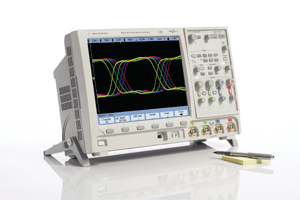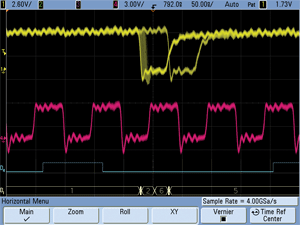Ten considerations for selecting an oscilloscope
With measurement requirements that span analog and digital domains, today’s designs add new wrinkles to choosing a scope
BY JOEL WOODWARD
Agilent Technologies
Santa Clara, CA
http://www.agilent.com
Oscilloscopes play a vital role in the design of increasingly sophisticated electronics. With signal measurement capabilities that span analog and digital domains, mixed-signal oscilloscopes (MSOs) have become extremely popular for debugging and testing those designs, and every major scope vendor now offers them in addition to traditional digital storage oscilloscopes (DSOs).

When matching your team’s needs with today’s oscilloscope features, here are 10 areas to consider.
1. Bandwidth
A critical decision is how much bandwidth. Analog bandwidth, which applies to just the analog channels, is paramount, since those channels are the heart of both DSOs and MSOs. Bandwidth is also the primary determinant of scope pricing.
Bandwidth is often thought of as the maximum frequency of a signal that can pass cleanly through the scope’s front-end amplifiers. In reality, most scope manufacturers define bandwidth as the frequency at which a sinusoidal input signal‘s amplitude will be attenuated by 3 dB, so the analog bandwidth of a scope must actually be higher than the maximum frequency to be measured. Choosing an scope–and probe system–with adequate bandwidth ensures accurate measurements.
This is particularly true for signals with fast edge speeds. One of the new bandwidth considerations is the increasing use of components based on leading-edge IC technologies. Even if the device has relatively slow bus speeds, advanced IC technologies have fast edge speeds with higher-frequency components.
2. MSO or DSO?
MSOs are priced 20% to 30% above the equivalent DSO. That is because MSOs offer digital measurement capability in addition to analog measurements. Those measurements can either be taken independently or simultaneously. In the latter case, the resulting measurements are automatically correlated in time.
Today, many development teams use off-the-shelf components — microprocessors, microcontrollers, DSPs, FPGAs, ASICs, ADCs, and DACs — as well as significant software content. In such applications, where there is a need to debug real-time hardware/software interactions, the MSO provides unique value. Since design anomalies can span analog and digital domains, the MSO adds significant debug capabilities not covered by a DSO. For example, using an MSO, a team can trigger on a PCI-bus write cycle while evaluating a control signal’s rise time.
3. Operating system
Most major scope vendors produce both Windows-based and non-Windows (RTOS-based) scopes. Windows-based scopes typically offer more analysis, application packages, better connectivity with PCs, and can host other PC-based applications.
RTOS-based scopes’ advantages include almost instantaneous boot up (under 30 s, versus a few minutes for Windows) and the ability to power down quickly and improperly without penalty.
Non-Windows scopes typically have higher software reliability, as their OSs are less susceptible to lockups and security issues. Finally, RTOS-based scopes are typically smaller and 20% to 30% less expensive than Windows-based ones, as they don’t require a “Wintel” motherboard or Microsoft software licensing royalties. These advantages typically make RTOS-based scopes a good fit for embedded applications.
4. Update rate
More than any other factor or specification, a scope’s update rate directly impacts three key attributes:
Responsiveness to setting changes.Ability to show subtle detail.Ability to capture infrequent events.
Digital scopes work by filling their memory buffer with signal detail, processing this information for viewing on the scope display, and then filling the memory buffer again. This repetitive process typically occurs at a much faster rate than the 60-Hz update rate of the LCD display. So multiple processed acquisitions are sent together to the LCD display for real-time signal viewing.
But while it is processing the previous acquisition, the scope is blind to changes that are currently occurring in signals being tested. Some scope architectures enable a fast waveform update rate that minimizes dead time and allows the instrument to show subtle signal detail and infrequent events. Others may have fast update rates with shallow memory, or fast update rates with analog channels only, but when digital channels are turned on, the update rate may drop by 2,000x.
An effective test of update rate test is to find a modulated signal, or one with jitter or an event that occurs infrequently. Turn on the scope-under-test’s deep memory and both its analog and digital channels. Observe the waveforms on the display. How fast are they updated? Do the analog waveforms look identical to the way they look with only analog channels turned on? Change the time-base setting and see how quickly the scope updates.
5. Memory depth
Memory depth is generally not well understood for digital scopes. Complicating the selection process is the fact that a user can’t always anticipate how much acquisition depth will be sufficient.
Deep memory lets scopes capture longer periods of time while maintaining fast sample rates, ensuring that important signal detail was captured. If a smaller amount of memory is used, their will not be enough data to accurately represent signal detail — users will zoom into dots
The architecture of a scope determines how effectively it can utilize the deep memory. For example, one MSO with 8 Msample memory will respond instantly when the user turns the knobs (see Fig. 1 ) and the display will have an accurate view of the signal being tested. Segmented memory techniques let the user capture pulses, bursts, and packets without expending memory on the dead time between these events.

Fig. 1. MSO7000 series scopes use a system-on-chip ASIC with deep memory to retain an update rate of 95,000 waveforms/s even with digital channels turned on.
Another MSO ships with a 10-Msample memory standard, but only 10-ksample enabled. Turning on the 10-Msample memory requires significant processing, which the instrument can’t do quickly. As a result, the display is sluggish when knobs are turned.
When evaluating a digital scope’s memory, determine how much comes standard on the instrument and how much is available in the default mode. If you enable the deepest memory offered, how responsive is the instrument when knobs are turned? Does the signal display quality (jitter, signal detail) degrade when deep memory is enabled?
6. Probing
A scope’s measurement is only as good as the probing used to connect the scope to the target. Loading, input amplitudes, and attenuation are all factors to consider. Differential probes are often needed for applications where noise immunity is essential. Current or high-voltage probes may be needed. If such probes are offered, how much do they add to the purchase price of the instrument?
7. Bus decoding
While most major oscilloscope vendors offer bus decode, their implementation approaches vary and impact the quality and usefulness of the tools. DSOs use the analog channels for this, which precludes their use for simultaneous measurement of other signals. MSOs use digital channels to probe and decode bus information, and analog channels to simultaneously capture waveforms.
Serial decode can result in a considerable penalty. If significant dead time occurs while the scope is post-processing the measurement, it may miss important activity. Instruments that decode using hardware deliver superior update rates compared to those that decode with software .
8. Setup/analysis time
A good way to evaluate a scope’s practical efficiency is to predefine several events that you normally need to capture, and time how long it takes you to make these measurements on each oscilloscope you are evaluating. Ask a colleague to run the same tests and you’ll have your own usability study.
Usability has two components—time to learn and time to relearn. Repeat the same measurements after a two day break and record your time.
9. Physical size
Where the scope will be used also impacts what to look for. If the scope will sit on a lab bench, a big screen and shallow depth will be key. Bigger displays have increased in importance as general-purpose scopes need to display more datadigital and serial signalsin addition to analog waveforms.
However, some teams prefer more traditional rugged form factors with lower profiles. If the scope needs to connect with other instruments in an ATE system, smaller screens usually need less rack height.
10. Application software
Scope vendors offer a variety of application software to customize general-purpose measurements. These apps give development teams faster, and often better, insight than they can achieve without it. Examples includes serial triggering and decode, on-chip FPGA debug, power analysis, and segmented memory. Application software can add 10% to 20% to the oscilloscope’s price a cost usually offset by productivity gains. ■
For more on oscilloscopes, visit http://electronicproducts-com-develop.go-vip.net/testmeasure.asp.
Advertisement
Learn more about Agilent Technologies





